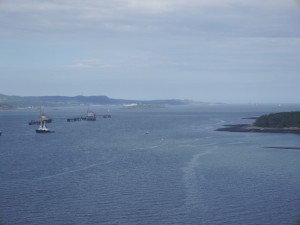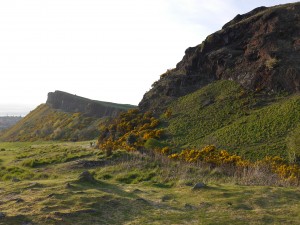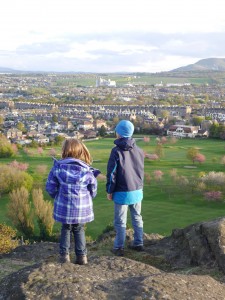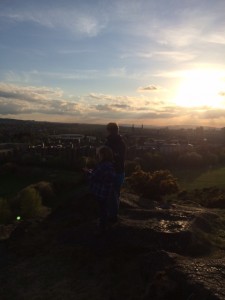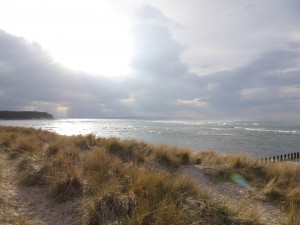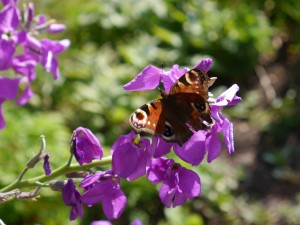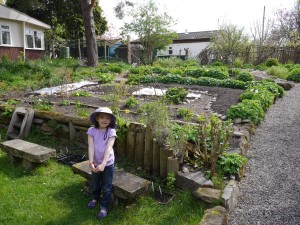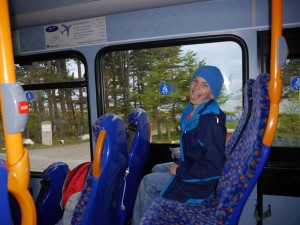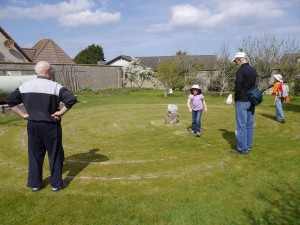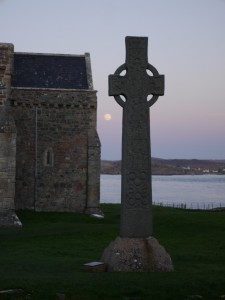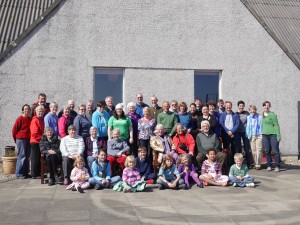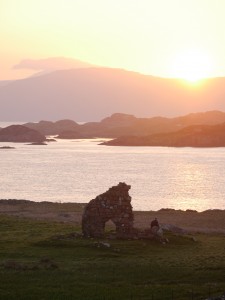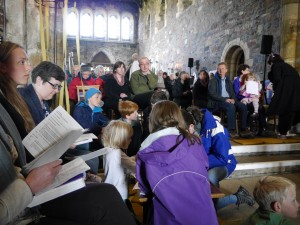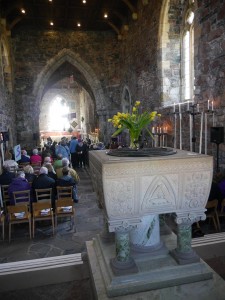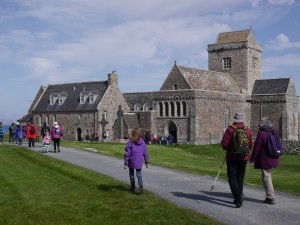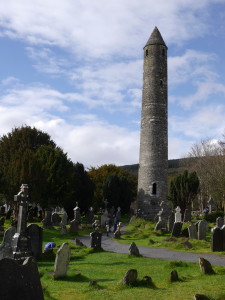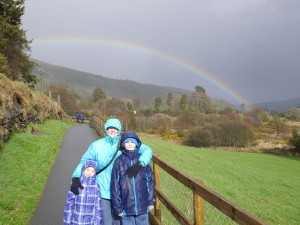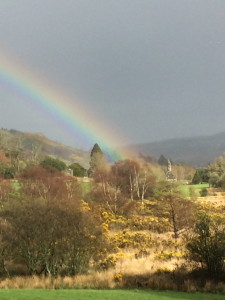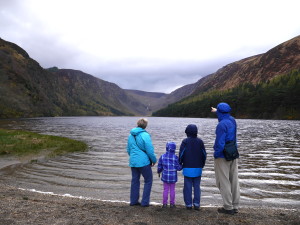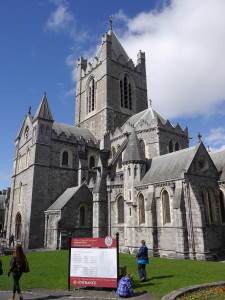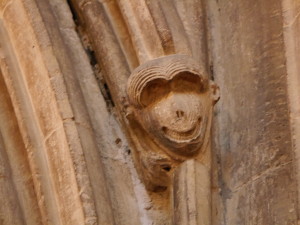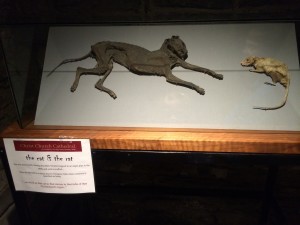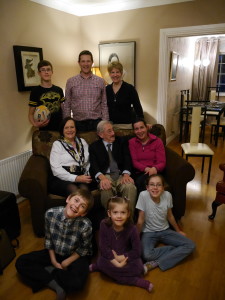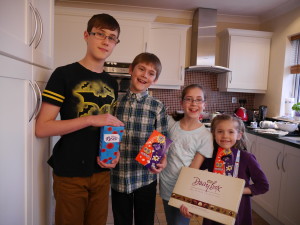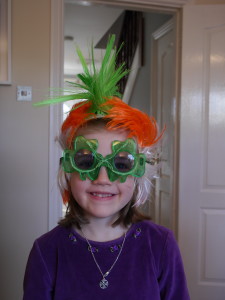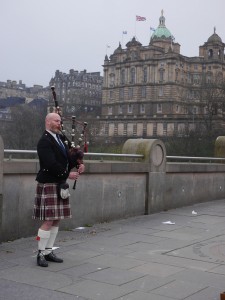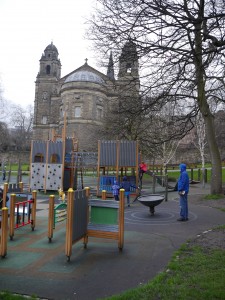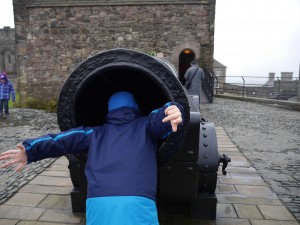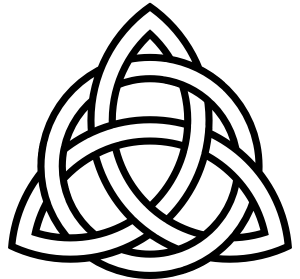We’d investigated the options for a tour from Dublin to New Grange to see ancient Irish artifacts and burial ground via a bus tour, but in order to do so, we had to first return the rental car we acquired for our visit to Glendalough the day before. This task proved to be much more complicated that it had any right to be, as the one-way streets and unfamiliar traffic patterns send us around and around in circles. As futility mounted, we made the decision to drop Chris and kids off near Trinity College for the tour bus pickup point, while I continued on the quest to find our rental car station, struggled through the maze of one-way streets as time slipped away. Meanwhile, Chris and kids got aboard the Mary Gibbons tour bus, and were traveling with it making additional pickups. The tour leader Mary tried to be as accommodating as possible, and Chris borrowed a local phone to contact me, but in the end it became was clear that there was no way I could conclude my rental car obligations before the tour deadline. So Chris and kids, greatly disappointed, had to step off the bus; the trip to New Grange denied.
What to do now? Today was to have been one of our great encounters with ancient Ireland…now it was ruined. Thank God Chris had wanted to go bring us to Glendalough—a place about which I new nothing, a place which, as it turned out, proved foundational and the first step on our Celtic pilgrimage. Not all was lost…we can move forward through this.
I walked, dejected, over to Trinity College, the place where we were to meet. And as I arrived I went onto the campus to see if I could locate the Book of Kells exhibit. It turned out to be easy to find the Library where it resides, and the lines to get in were, it turned out, exceptionally short. Perhaps as a consolation we could all take in this exhibit—which was something we had hoped and planned to do in any event while in Dublin.
Walking back to our meeting place just outside the Trinity College campus, and met Chris, Kai and Naomi as they arrived. We embraced and expressed our deep frustration and disappointment at the loss of the New Grange opportunity. Then I told them about the Book of Kells exhibit. Perhaps seeing the Book of Kells would blunt our disappointment. We went in, and soon became engrossed in the comprehensive exhibit, which included displays and videos on the craft of making ancient manuscripts with all the steps down to the minutest detail. It was fantastic! And then we got to see the book itself, under glass and dim light. (The pages are changed regularly to keep it from growing more faded after 13 hundred years.) We also saw additional manuscripts from the ancient monastic tradition. Truly remarkable .
.
The Book of Kells is thought to have been written and illuminated on the Isle of Iona in the 8th century, perhaps to honor St. Columba, before being brought for safe keeping to Kells in the wake of attacks on the island by marauding Vikings in the 9th century. It was stolen in the 11th century, at which time its cover was torn off and it was thrown into a ditch. The cover, which most likely included gold and gems, has never been found, and the book suffered some water damage; but otherwise it is extraordinarily well-preserved. In 1541, at the height of the English Reformation, the book was taken by the Roman Catholic Church for safekeeping. It was returned to Ireland in the 17th century, and Archbishop James Ussher gave it to Trinity College, Dublin, where it resides today. The Book of Kells was written on vellum (calfskin), which was time-consuming to prepare properly but made for an excellent, smooth writing surface. 680 individual pages (340 folios) have survived, and of them only two lack any form of artistic ornamentation. In addition to incidental character illuminations, there are entire pages that are primarily decoration, including portrait pages, “carpet” pages and partially decorated pages with only a line or so of text. As many as ten different colors were used in the illuminations, some of them rare and expensive dyes that had to be imported from the continent. We saw examples of the raw pigments in the exhibit. The main focus of the book is the Four Gospels. Each one is preceded by a carpet page featuring the Gospel’s author—Matthew, Mark, Luke or John.
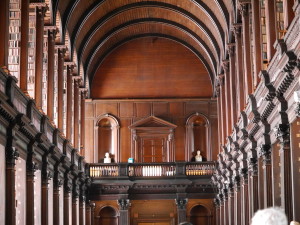 Upstairs in the Trinity College library we discovered another exhibit about Brian Boru (11th century), with a series of gorgeous contemporary silk paintings depicting this Norse saga, and the oldest surviving harp in Ireland—a willow and
Upstairs in the Trinity College library we discovered another exhibit about Brian Boru (11th century), with a series of gorgeous contemporary silk paintings depicting this Norse saga, and the oldest surviving harp in Ireland—a willow and 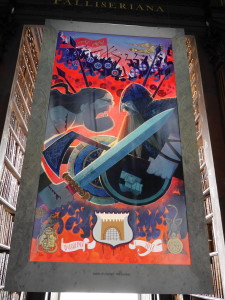 oak harp associated (wrongly, it turns out) with Boru. This harp actually dates from the 15th century.) The library itself looks like somethin
oak harp associated (wrongly, it turns out) with Boru. This harp actually dates from the 15th century.) The library itself looks like somethin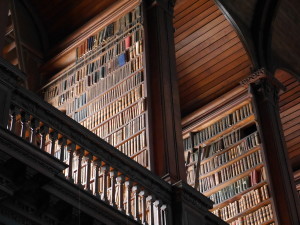 g you would find at Hogwarts, with a great central room with plenty of natural light rising up several floors over the main floor reading area.
g you would find at Hogwarts, with a great central room with plenty of natural light rising up several floors over the main floor reading area.
Leaving the exhibit we found a gift shop downstairs where we picked up several souvenirs and gifts. But the purchase that was most consequential was a miniature rugby ball Kai had his heart set on. (That ball proved to be one of the best purchases we would make on our whole trip!) By now we were famished, and were directed by a store host to a wonderful buffet restaurant across the street where we found a wonderful, hot meal in a warm and lively atmosphere. By the end of lunch we were fully recovered from our misadventures.
The day is still young, however, so we take our time strolling back toward our apartment, stopping to play at the park adjacent to St. Patrick’s Cathedral. There we enjoy tossing the miniature rugby ball, playing on the structure, and just enjoying the beautiful afternoon.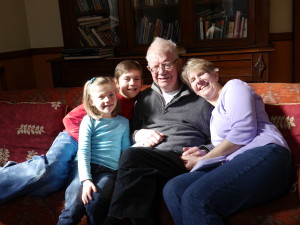
Then it’s on to see Father Martin Nolan, former head of the Augustinian Order, retired Roman Catholic priest, and close friend of the Hauger family whom Chris and her family first met when they were stationed in Nigeria in 1969. We are relieved and happy that Martin, who was recovering from a stroke, is able to spend an hour with us alone, and we enjoy our visit with him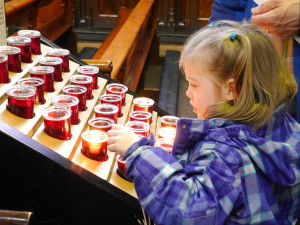 immensely. After hugs, kisses, and good-byes, we entered St. John’s Church and, in a custom that would be observed throughout our travels, light candles as gestures of prayer for Martin and others we love.
immensely. After hugs, kisses, and good-byes, we entered St. John’s Church and, in a custom that would be observed throughout our travels, light candles as gestures of prayer for Martin and others we love.
Now, after a very full day, it is dinnertime. Where to go? We walk past Christ Church and toward the Temple Bar district, but nothing appeals to us. Many of those restaurants stop serving food and concentrate on drink fairly early in the evening. After walking a few blocks further, we turn around, and as we begin to walk back,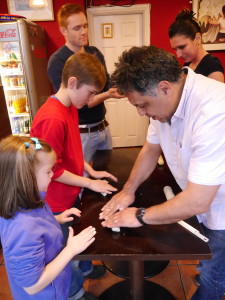 hunger pains increasing, Kai spies the AZTECA restaurant across the street. Mexican food in Dublin? Why not! Over we go.
hunger pains increasing, Kai spies the AZTECA restaurant across the street. Mexican food in Dublin? Why not! Over we go.
Stepping inside 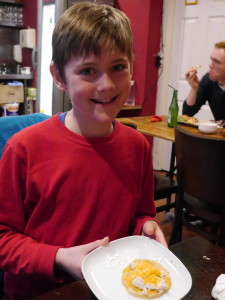 the small restaurant we are welcomed by Antonio and see a young couple engaged in what looks like a cooking lesson. Kai and Naomi, naturally curious, go over to watch the cooking lesson and in moments the host and owner of the restaurant, Hugo, invites them to join in! They wash hands, get aprons, and proceed to make what will be their own dinner…a wonderful serendipitous experience, so unexpected and wonderful, that brings the day to an end in a memorable way.
the small restaurant we are welcomed by Antonio and see a young couple engaged in what looks like a cooking lesson. Kai and Naomi, naturally curious, go over to watch the cooking lesson and in moments the host and owner of the restaurant, Hugo, invites them to join in! They wash hands, get aprons, and proceed to make what will be their own dinner…a wonderful serendipitous experience, so unexpected and wonderful, that brings the day to an end in a memorable way. 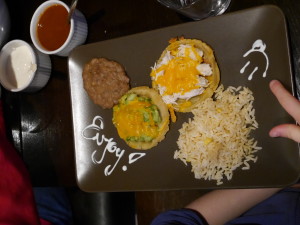
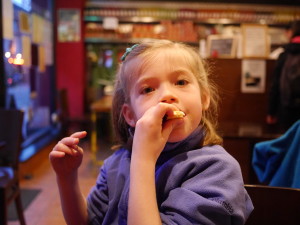
The day we experienced turned out to be so different from what we had planned. Yet, every part of it was significant and taught us something about the need for flexibility and serendipity on this sabbatical journey. Hopefully these are lessons we’ll keep close to us in the day and weeks ahead.

